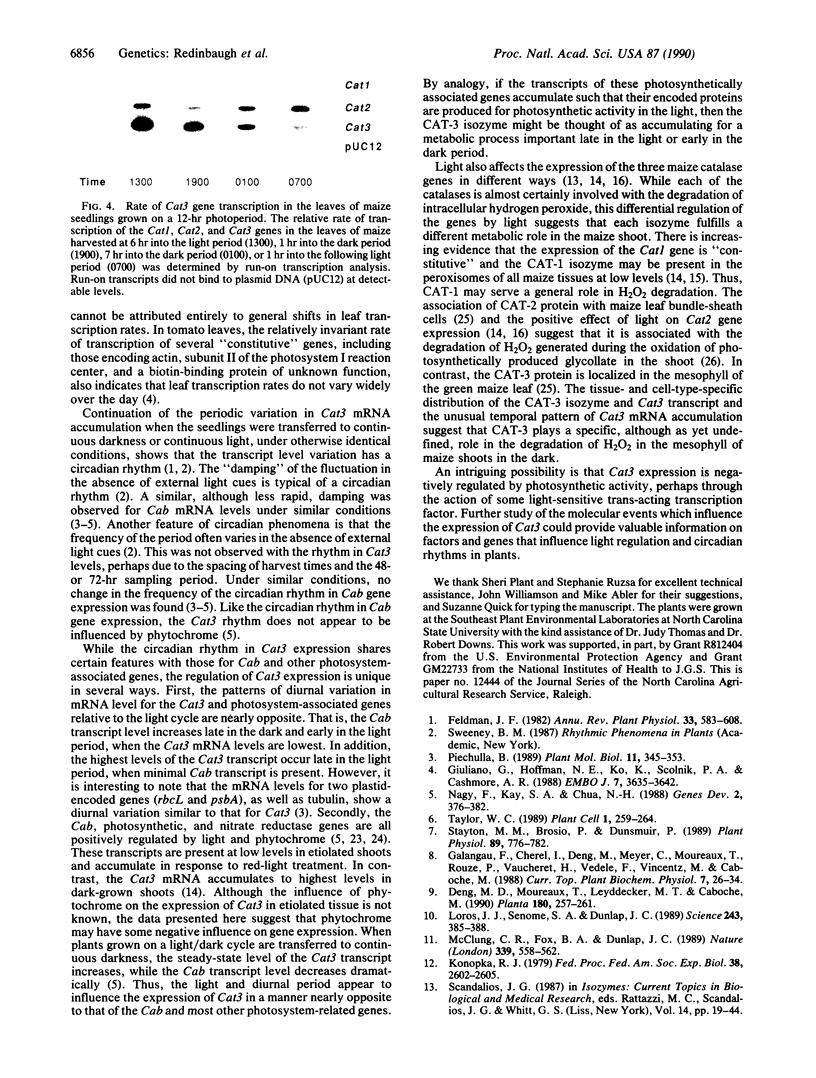Abstract
The accumulation of Cat3 catalase mRNA in the green leaves of maize (Zea mays) exhibits an unusual circadian rhythm. The steady-state level of the Cat3 transcript varies dramatically over the day in seedlings grown on a 12-hr photoperiod. Low or undetectable levels of the Cat3 mRNA are found late in the dark and early in the light period, while the transcript accumulates to high levels late in the light and early in the dark period. This dramatic diurnal variation in mRNA level does not occur with the maize Cat1 or Cat2 catalase transcripts. The diurnal fluctuation in Cat3 mRNA persists when the seedlings are transferred to continuous light or darkness, which indicates the influence of a circadian rhythm. The lack of influence of red and/or far-red light on this diurnal variation in transcript level indicates that the circadian rhythm is not regulated by phytochrome. Run-on transcription assays show that changes in the rate of Cat3 gene transcription closely parallel the observed changes in steady-state mRNA levels. This circadian rhythm in Cat3 gene expression and the resulting high levels of mRNA which accumulate late in the light period suggest that the catalase 3 (CAT-3) isozyme is being synthesized for accumulation in the dark period. This, together with the high level of Cat3 mRNA and CAT-3 protein accumulation in dark-grown maize shoots, suggests that the activity of the CAT-3 isozyme might be associated with a metabolic process important in shoot cells in the dark.
Full text
PDF




Images in this article
Selected References
These references are in PubMed. This may not be the complete list of references from this article.
- Bethards L. A., Skadsen R. W., Scandalios J. G. Isolation and characterization of a cDNA clone for the Cat2 gene in maize and its homology with other catalases. Proc Natl Acad Sci U S A. 1987 Oct;84(19):6830–6834. doi: 10.1073/pnas.84.19.6830. [DOI] [PMC free article] [PubMed] [Google Scholar]
- Giuliano G., Hoffman N. E., Ko K., Scolnik P. A., Cashmore A. R. A light-entrained circadian clock controls transcription of several plant genes. EMBO J. 1988 Dec 1;7(12):3635–3642. doi: 10.1002/j.1460-2075.1988.tb03244.x. [DOI] [PMC free article] [PubMed] [Google Scholar]
- Hagen G., Guilfoyle T. J. Rapid induction of selective transcription by auxins. Mol Cell Biol. 1985 Jun;5(6):1197–1203. doi: 10.1128/mcb.5.6.1197. [DOI] [PMC free article] [PubMed] [Google Scholar]
- Konopka R. J. Genetic dissection of the Drosophila circadian system. Fed Proc. 1979 Nov;38(12):2602–2605. [PubMed] [Google Scholar]
- Loros J. J., Denome S. A., Dunlap J. C. Molecular cloning of genes under control of the circadian clock in Neurospora. Science. 1989 Jan 20;243(4889):385–388. doi: 10.1126/science.2563175. [DOI] [PubMed] [Google Scholar]
- McClung C. R., Fox B. A., Dunlap J. C. The Neurospora clock gene frequency shares a sequence element with the Drosophila clock gene period. Nature. 1989 Jun 15;339(6225):558–562. doi: 10.1038/339558a0. [DOI] [PubMed] [Google Scholar]
- Rajasekhar V. K., Gowri G., Campbell W. H. Phytochrome-mediated light regulation of nitrate reductase expression in squash cotyledons. Plant Physiol. 1988 Oct;88(2):242–244. doi: 10.1104/pp.88.2.242. [DOI] [PMC free article] [PubMed] [Google Scholar]
- Redinbaugh M. G., Sabre M., Scandalios J. G. The distribution of catalase activity, isozyme protein, and transcript in the tissues of the developing maize seedling. Plant Physiol. 1990 Feb;92(2):375–380. doi: 10.1104/pp.92.2.375. [DOI] [PMC free article] [PubMed] [Google Scholar]
- Redinbaugh M. G., Wadsworth G. J., Scandalios J. G. Characterization of catalase transcripts and their differential expression in maize. Biochim Biophys Acta. 1988 Nov 10;951(1):104–116. doi: 10.1016/0167-4781(88)90030-9. [DOI] [PubMed] [Google Scholar]
- Skadsen R. W., Scandalios J. G. Translational control of photo-induced expression of the Cat2 catalase gene during leaf development in maize. Proc Natl Acad Sci U S A. 1987 May;84(9):2785–2789. doi: 10.1073/pnas.84.9.2785. [DOI] [PMC free article] [PubMed] [Google Scholar]
- Stayton M. M., Brosio P., Dunsmuir P. Photosynthetic Genes of Petunia (Mitchell) Are Differentially Expressed during the Diurnal Cycle. Plant Physiol. 1989 Mar;89(3):776–782. doi: 10.1104/pp.89.3.776. [DOI] [PMC free article] [PubMed] [Google Scholar]
- Taylor W. C. Transcriptional regulation by a circadian rhythm. Plant Cell. 1989 Feb;1(2):259–264. doi: 10.1105/tpc.1.2.259. [DOI] [PMC free article] [PubMed] [Google Scholar]
- Tsaftaris A. S., Bosabalidis A. M., Scandalios J. G. Cell-type-specific gene expression and acatalasemic peroxisomes in a null Cat2 catalase mutant of maize. Proc Natl Acad Sci U S A. 1983 Jul;80(14):4455–4459. doi: 10.1073/pnas.80.14.4455. [DOI] [PMC free article] [PubMed] [Google Scholar]
- Wadsworth G. J., Redinbaugh M. G., Scandalios J. G. A procedure for the small-scale isolation of plant RNA suitable for RNA blot analysis. Anal Biochem. 1988 Jul;172(1):279–283. doi: 10.1016/0003-2697(88)90443-5. [DOI] [PubMed] [Google Scholar]
- Wadsworth G. J., Scandalios J. G. Differential expression of the maize catalase genes during kernel development: the role of steady-state mRNA levels. Dev Genet. 1989;10(4):304–310. doi: 10.1002/dvg.1020100405. [DOI] [PubMed] [Google Scholar]











